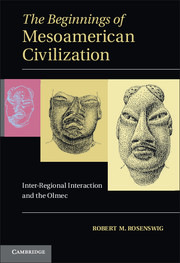Book contents
- Frontmatter
- Contents
- Figures
- Tables
- Acknowledgments
- SECTION I AN EARLY FORMATIVE MESOAMERICAN PROBLEM
- SECTION II ARCHAEOLOGICAL DATA
- 4 Settlement Patterns and Architecture
- 5 Diet, Food Processing and Feasting
- 6 Representation and Aesthetics
- 7 Inter-regional Exchange Patterns
- SECTION III DERIVING MEANING FROM THE ARCHAEOLOGICAL RECORD
- 9 Conclusion
- Appendix 1 Temporally secure excavation contexts at Cuauhtémoc with detailed ceramic data
- Appendix 2 Temporally secure excavation contexts at Cuauhtémoc without detailed ceramic data
- References Cited
- Index
4 - Settlement Patterns and Architecture
Published online by Cambridge University Press: 26 February 2010
- Frontmatter
- Contents
- Figures
- Tables
- Acknowledgments
- SECTION I AN EARLY FORMATIVE MESOAMERICAN PROBLEM
- SECTION II ARCHAEOLOGICAL DATA
- 4 Settlement Patterns and Architecture
- 5 Diet, Food Processing and Feasting
- 6 Representation and Aesthetics
- 7 Inter-regional Exchange Patterns
- SECTION III DERIVING MEANING FROM THE ARCHAEOLOGICAL RECORD
- 9 Conclusion
- Appendix 1 Temporally secure excavation contexts at Cuauhtémoc with detailed ceramic data
- Appendix 2 Temporally secure excavation contexts at Cuauhtémoc without detailed ceramic data
- References Cited
- Index
Summary
If the capital city of a world-economy fell, it sent ripples throughout the system to the periphery. And it is indeed in these marginal regions…that one can often best observe what is happening.
Braudel 1992: 34The southeastern half of the Soconusco is approximately 60 km long, 30 to 40 km wide and is framed on all sides by a geographic barrier (Figure 2.1). To the southwest is the Pacific Ocean, to the northeast is the Sierra Madre and to both the northwest and the southeast are two enormous estuary–lagoon systems: La Cantileña and Guamuchal/Manchón (see Voorhies 2004: 6–13, 20–21). This relatively small area in between has the greatest concentration of fertile land on the Pacific coast of Mexico and Guatemala and today is used to grow many crops including banana, mango, papaya, sesame seed and cacao. The area to the northwest of the Cantileña swamp system contains poor gravelly soils with lower rainfall and thus relatively unproductive agricultural lands (Lowe 1977: 202). In fact, the area between Pijijiapan and Tonalá was called the despoblado del Soconusco in colonial times (Orellana 1995: 11). Today, the area is still sparsely populated and primarily used to graze cattle. To the southeast of the Soconusco, beyond the Guamuchal/Manchón swamp system, the coastal plain becomes wider and the piedmont is further from the ocean. In this region of the Guatemalan coast, estuary swamp systems do not form behind the beaches, and the soils contain so much clay that maize is not grown (Neff et al. 2006c: 299).
- Type
- Chapter
- Information
- The Beginnings of Mesoamerican CivilizationInter-Regional Interaction and the Olmec, pp. 105 - 131Publisher: Cambridge University PressPrint publication year: 2009



